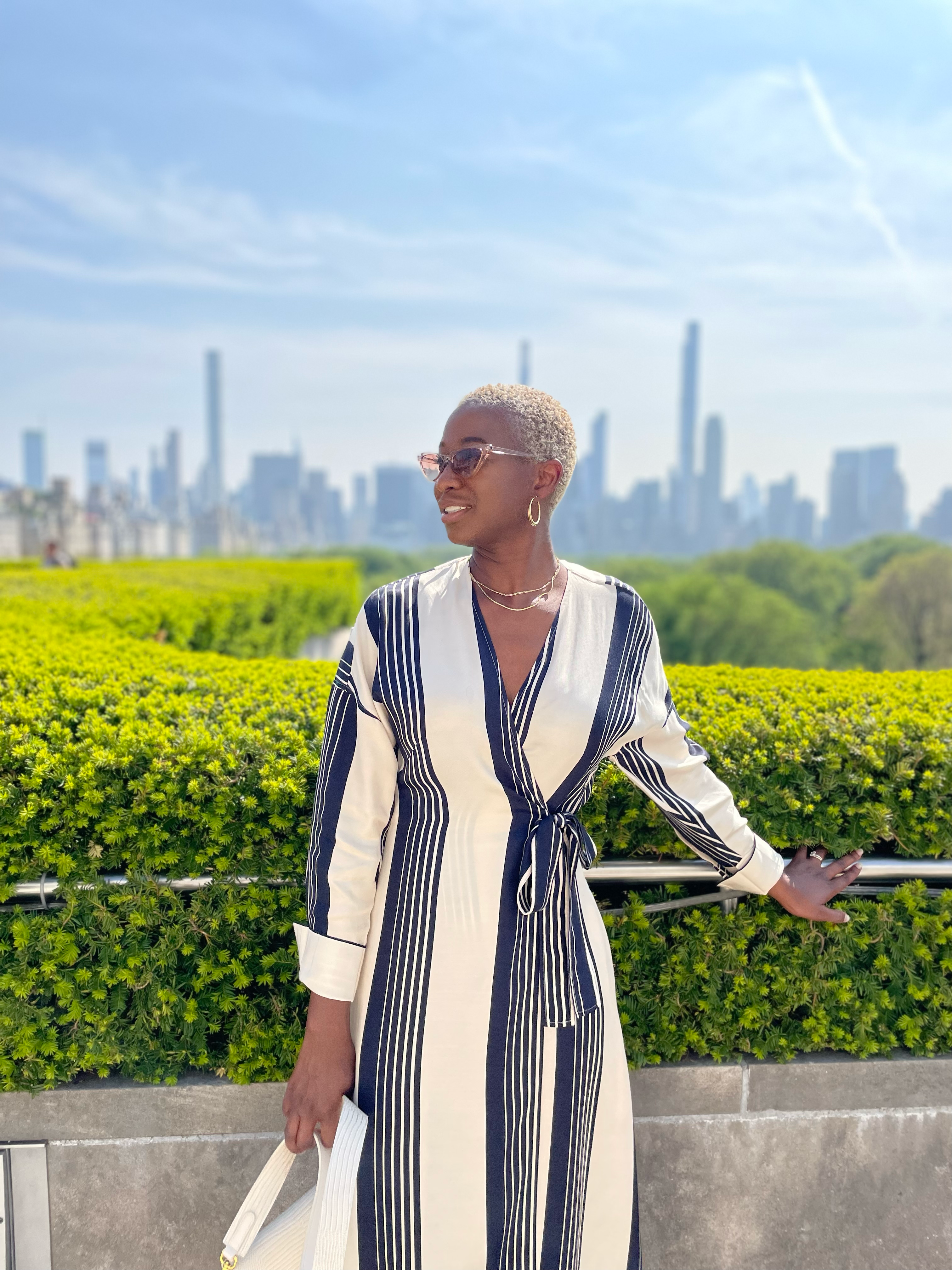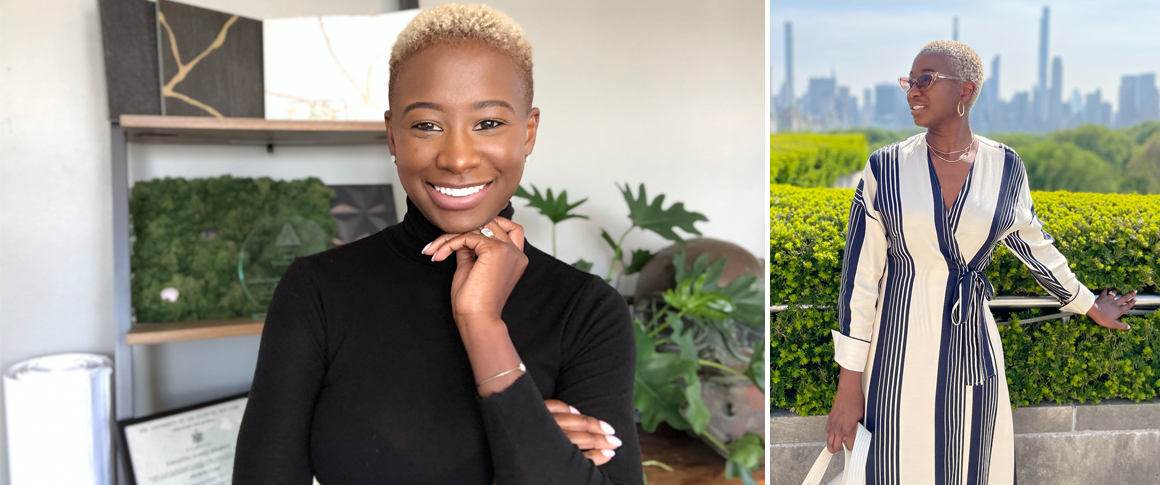When architect Samantha Josaphat earned her license in 2017, she became the 397th Black woman in the United States to reach that milestone. At the time, there were over 109,000 architects practicing in the U.S. Today, Black women still make up less than half a percent of licensed architects.
Samantha went on to found her own firm, Studio 397, commemorating her place in history and calling attention to architecture’s ongoing representation gap.
“So I found out that there was an African American Directory of Black architects within the states while I was in college, and I remember joking with myself and saying, ‘I’m going to make that list before they hit 400,’ not realizing what that meant,” says Samantha.
“And then I found out that I was 397. And I thought, ‘It’s kind of wild that I’m the 397th Black female architect in all of U.S. history when I graduated with a high school class of about 300.’”
Now a leader and a mentor in the profession, Samantha is involved in guiding the next generation of architects at every career stage from middle school to licensure, using her own experiences to help her candidates plan strategically.
Make a Plan and Pace Yourself
Nearly 40% of licensure candidates take more than 15 years to earn their license (including education, experience, and examination), but Samantha earned her license in 11—including one year in school with an undecided major, five years in architecture school, and two years working prior to two and a half years taking the exam).
“I was like, ‘Alright Samantha, it’s time to go to war.’ I was so focused. It took me two and a half years to take the exam, but that was two and a half years of consistent studying, of knowing that if I fail an exam, I can’t let it slow me down. It didn’t feel quick, but it wasn’t until I heard other stories.”

Now, Samantha advises candidates to maintain their momentum through the licensure process. “If you’re taking an exam every four months, and there are twelve months in a year (but you’re taking summer off), technically you only have time to take two to three exams—and that's if you pass. So if you fail, you’re adding another year.”
“I want people to be conscious of the overall process. Don’t look at the end result but look at the overall process, so that you know how you’re pacing yourself—so that halfway through the journey, you’re not beating yourself up because time went by.”
“And I do encourage people to test right after school if they can, as it was a learning lesson for me. There were some things the exams taught me that I wouldn’t learn in the office because I didn’t have access to that opportunity, that’s one example how my exams helped me develop professionally.”
Earning a license was an important milestone for Samantha: “I joke, and say, those were my freedom papers. That was my way of being able to say I’m qualified.” However, not all of her superiors respected the growth and competency that went into earning her license.
“I learned later on that people still didn’t respect that I had this qualification, and I think it was because of my youth. That’s what made me go out on my own. I’ll never be enough, so let me just go out and do this on my own instead of trying to prove myself to someone who has no interest in seeing me develop,” says Samantha.
Taking the First Step
Now, Samantha focuses on helping the licensure candidates who work at her firm develop their professional skills:
“The licensure journey is very personal, so I didn’t want to get too involved. It’s uncomfortable to share with people, ‘I’m taking an exam’ when you might not pass it. What’s important to me is to make sure that they started,” Samantha shares. So Samantha and her business partner push their candidates to start the exams, but then, they back off—ensuring that their candidates have the support and resources to continue taking their exams, while still giving them space to navigate their personal journey.
“Sometimes they’ll write us via our internal chat and ask us a study question, and we’ll write back responses as a team. And if we realize that we’re all getting the answer wrong, then we look at the question as a team and research how that answer comes about. So we kind of have a small study session with them, but only when they want that to happen,” she explains.
Finding Experience Opportunities
As a firm, Studio 397 consciously partners with other firms on larger projects—including the reconstruction of New York City’s Penn Station, a partnership with FX Collaborative, WSP, and John McAslan + Partners. These partnerships help draw connections for her candidates on their Architectural Experience Program® (AXP®) journey:
“Because our projects range from small to mid-size, and the projects we collaborate with other architecture firms tend to be on a larger scale, there are some things on those projects that our team gets access to that they wouldn’t have access to on a smaller projects, because the scope or the budget don’t allow for that level of complexity. It’s been helpful for them to participate in on certain meetings where they make those connections,” Samantha explains.
This approach is intentionally strategic. “Both myself and my business partner worked on larger projects prior to the formation of STUDIO 397, and we know the access to information you get on certain types of projects of that scale,” shares Samantha. “So it was important to us that we’re not limiting our team, but giving them access to additional information outside of the typical project type that we used to work on.”
Mentoring the Next Generation
In addition to leading her firm, Samantha also teaches first-year architecture students at Cooper Union. “A lot of times, the classes I teach are first-year students, so they’re still very, very fresh on the idea of architecture outside of whatever they’ve watched on TV or seen on Instagram,” says Samantha. “It’s really about teaching them the creative thinking process before we even move into place-making.”
Samantha’s conscious of being a Black female architect in the mentor role: “I do find a sense of pride being able to show myself to a range of students, so they are also aware of the different types of architects that are out there,” she explains. And through NOMA’s Project Pipeline, Samantha is hoping to reach an even broader range of future architects:
“We do try to reach out to them at an early stage [between 9 and 14 years old] so they have this understanding of architecture,” she says. “That way, when they are in school or in a program where someone is asking, ‘What is your interest? What track can I guide you on?’ they already have an understanding of what an architect is.”
In Project Pipeline, nycoba|NOMA meets students where they are. “We typically go to their school or a community center in their neighborhood. And we’ll initially give them a list of architectural elements, and we’ll talk to them about the function of each element means, like what a windowsill is, what a parapet is. So they learn all these different architectural terms, and then we go out into their neighborhood as if we’re scavenger hunting and looking for all these elements. Now they’re looking at their community and their neighborhood completely different, because now they have a new lens.”
For Samantha, it goes beyond reaching the students who attend Project Pipeline camps. “I know we’re reaching far beyond just the students we’re interacting with. We’re creating this network where they can share the knowledge of architecture to others,” she shares.
Discovering (And Re-Discovering) Passion
As a professor, mentor, and firm owner, Samantha is careful not to diminish the passion that her students have for architecture: “I don’t want to jade them, because it’s great for people to be excited about the profession. What I lost after I went to the real world was that passion, and I had to go find it again,” she says.
And how do you re-discover your passion? “Explore a different direction. It wasn’t until I made a completely different shift in how I was going to approach my career in architecture that I saw a difference in my career,” Samantha advises. “It could be the environments you’re putting yourself in versus your actual interest. Try something extremely different that is still within the profession, or has you involved with the profession, and see if the passion is there.”
